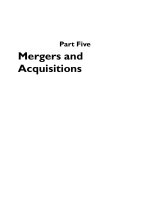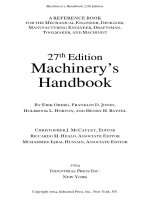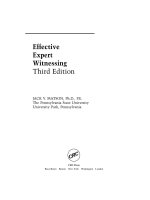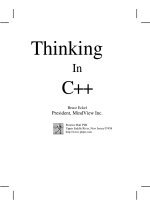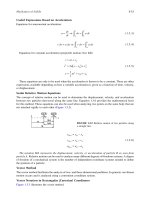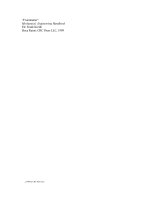Tài liệu GasTurbine Engineering Handbook Second Edition doc
Bạn đang xem bản rút gọn của tài liệu. Xem và tải ngay bản đầy đủ của tài liệu tại đây (10.34 MB, 816 trang )
F:/GTE/FINAL (26-10-01)/FRONT MATTER.3D ± 1 ± [1±16/16] 1.11.2001 12:46PM
Ga sTurbine
Engineering
Ha ndbook
Second Edition
F:/GTE/FINAL (26-10-01)/FRONT MATTER.3D ± 2 ± [1±16/16] 1.11.2001 12:46PM
F:/GTE/FINAL (26-10-01)/FRONT MATTER.3D ± 3 ± [1±16/16] 1.11.2001 12:46PM
GasTurbine
Engineering
Handbook
Second Edition
Meherwan P. Boyce
Managing Partner, The Boyce Consultancy
Fellow, American Society of Mechanical Engineers
Fellow, Institute of Diesel and Gas Turbine Engineers, U.K.
Boston Oxford Auckland Johannesburg Melbourne New Delhi
F:/GTE/FINAL (26-10-01)/FRONT MATTER.3D ± 4 ± [1±16/16] 1.11.2001 12:46PM
Gulf Professional Publishing is an imprint of Butterworth
Â
±Heinemann.
Copyright
#
2002 by Butterworth
Â
±Heinemann. Previously copyrighted
#
1995. 1982 by Gulf
Publishing Company, Houston, Texas
A member of the Reed Elsevier group
All rights reserved.
No part of this publication may be reproduced, stored in a retrieval system, or transmitted
in any form or by any means, electronic, mechanical, photocopying, recording, or
otherwise, without the prior written permission of the publisher.
Recognizing the importance of preserving what has been written, Butterworth
Â
±Heinemann
prints its books on acid-free paper whenever possible.
Butterworth
Â
±Heinemann supports the efforts of American Forests and the Global
ReLeaf program in its campaign for the betterment of trees, forests, and our
environment.
Library of Congress Cataloging-in-Publication Data
Boyce, Meherwan P.
Gas turbine engineering handbook / Meherwan P. Boyce. ± 2nd ed.
p. cm.
Includes bibliographical references and index.
ISBN 0-88415-732-6 (alk. paper)
1. Gas-turbines±Handbooks, manuals, etc. I. Title.
TJ778 .B67 2001
621.43
H
3±dc21
2001040520
British Library Cataloguing-in-Publication Data
A catalogue record for this book is available from the British Library.
Illustration Credit: Unless otherwise cited, the illustrations appearing in this book are
supplied courtesy and used with the permission of the Turbomachinery Laboratories,
Department of Mechanical Engineering, Texas A&M University, College Station, Texas
77843. These illustrations were published and are copyright
#
by the Turbomachinery
Laboratories in the annual proceedings of their Turbomachinery Symposia.
The publisher offers special discounts on bulk orders of this book.
For information, please contact:
Manager of Special Sales
Butterworth
Â
±Heinemann
225 Wildwood Avenue
Woburn, MA 01801-2041
Tel: 781-904-2500
Fax: 781-904-2620
For information on all Gulf Professional Publishing publications available, contact our World
Wide Web home page at:
10987654321
Printed in the United States of America
F:/GTE/FINAL (26-10-01)/FRONT MATTER.3D ± 5 ± [1±16/16] 1.11.2001 12:46PM
To the memory of my father, Phiroz H.J. Boyce
F:/GTE/FINAL (26-10-01)/FRONT MATTER.3D ± 6 ± [1±16/16] 1.11.2001 12:46PM
F:/GTE/FINAL (26-10-01)/FRONT MATTER.3D ± 7 ± [1±16/16] 1.11.2001 12:46PM
Contents
Preface . . . . . . . . . . . . . . . . . . . . . . . . . . . . . . . . . . . . . . x
Preface to the First Edition . . . . . . . . . . . . . . . . . . . . . . . . . . . xii
Foreword to the First Edition . . . . . . . . . . . . . . . . . . . . . . . . . . xiv
Part I Design: Theory and Practice
1 An Overview of Gas Turbines . . . . . . . . . . . . . . . . . . . . . . . . 3
Gas Turbine Cycle in the Combined Cycle or Cogeneration Mode. Gas Turbine Performance.
Gas Turbine Design Considerations. Categories of Gas Turbines. Major Gas Turbine Compon-
ents. Fuel Type. Environmental Effects. Turbine Expander Section. Materials. Coatings. Gas
Turbine Heat Recovery. Supplementary Firing of Heat Recovery Systems. Bibliography.
2 Theoretical and Actual Cycle Analysis. . . . . . . . . . . . . . . . . . . 58
The Brayton Cycle. Actual Cycle Analysis. Summation of Cycle Analysis. A General Overview
of Combined Cycle Plants. Compressed Air Energy Storage Cycle. Power Augmentation.
Summation of the Power Augmentation Systems. Bibliography.
3 Compressor and Turbine Performance Characteristics . . . . . . . . . .112
Turbomachine Aerothermodynamics. The Aerothermal Equations. Efficiencies. Dimensional
Analysis. Compressor Performance Characteristics. Turbine Performance Characteristics. Gas
Turbine Performance Computation. Bibliography.
4 Performance and Mechanical Standards. . . . . . . . . . . . . . . . . .141
Major Variables for a Gas Turbine Application. Performance Standards. Mechanical Parameters.
Application of the Mechanical Standards to the Gas Turbine. Specifications. Bibliography.
5 Rotor Dynamics . . . . . . . . . . . . . . . . . . . . . . . . . . . . . .178
Mathematical Analysis. Application to Rotating Machines. Critical Speed Calculations for Rotor
Bearing Systems. Electromechanical Systems and Analogies. Campbell Diagram. Bibliography.
Part II Major Components
6 Centrifugal Compressors. . . . . . . . . . . . . . . . . . . . . . . . . .221
Centrifugal Compressor Components. Centrifugal Compressor Performance. Compressor
Surge. Process Centrifugal Compressors. Bibliography.
7 Axial-Flow Compressors . . . . . . . . . . . . . . . . . . . . . . . . . .275
Blade and Cascade Nomenclature. Elementary Airfoil Theory. Laminar-Flow Airfoils. Cascade
Test. Velocity Triangles. Degree of Reaction. Radial Equilibrium. Diffusion Factor. The
Incidence Rule. The Deviation Rule. Compressor Stall. Performance Characteristics of an
Axial-Flow Compressor. Stall Analysis of an Axial-Flow Compressor. Bibliography.
8 Radial-Inflow Turbines . . . . . . . . . . . . . . . . . . . . . . . . . . .319
Description. Theory. Turbine Design Considerations. Losses in a Radial-Inflow Turbine.
Performance of a Radial-Inflow Turbine. Bibliography.
vii
F:/GTE/FINAL (26-10-01)/FRONT MATTER.3D ± 8 ± [1±16/16] 1.11.2001 12:46PM
9 Axial-Flow Turbines . . . . . . . . . . . . . . . . . . . . . . . . . . . .337
Turbine Geometry. Impulse Turbine. The Reaction Turbine. Turbine Blade Cooling Concepts.
Turbine Blade Cooling Design. Cooled-Turbine Aerodynamics. Turbine Losses. Bibliography.
10 Combustors . . . . . . . . . . . . . . . . . . . . . . . . . . . . . . . .370
Combustion Terms. Combustion. Combustion Chamber Design. Fuel Atomization and
Ignition. Typical Combustor Arrangements. Air Pollution Problems. Catalytic Combustion.
Bibliography.
Part III Materials, Fuel Technology, and Fuel Systems
11 Materials . . . . . . . . . . . . . . . . . . . . . . . . . . . . . . . . . .411
General Metallurgical Behaviors in Gas Turbines. Gas Turbine Materials. Compressor Blades.
Forgings and Nondestructive Testing. Coatings. Bibliography.
12 Fuels . . . . . . . . . . . . . . . . . . . . . . . . . . . . . . . . . . . .436
Fuel Specifications. Fuel Properties. Fuel Treatment. Heavy Fuels. Cleaning of Turbine
Components. Fuel Economics. Operating Experience. Heat Tracing of Piping Systems. Types
of Heat-Tracing Systems. Storage of Liquids. Bibliography.
Part IV Auxiliary Components and Accessories
13 Bearings and Seals. . . . . . . . . . . . . . . . . . . . . . . . . . . . .469
Bearings. Bearing Design Principles. Tilting-Pad Journal Bearings. Bearing Materials. Bearing
and Shaft Instabilities. Thrust Bearings. Factors Affecting Thrust-Bearing Design. Thrust-
Bearing Power Loss. Seals. Noncontacting Seals. Mechanical (Face) Seals. Mechanical Seal
Selection and Application. Seal Systems. Associated Oil System. Dry Gas Seals. Bibliography.
14 Gears . . . . . . . . . . . . . . . . . . . . . . . . . . . . . . . . . . . .521
Gear Types. Factors Affecting Gear Design. Manufacturing Processes. Installation and Initial
Operation. Bibliography.
Part V Installation, Operation, and Maintenance
15 Lubrication . . . . . . . . . . . . . . . . . . . . . . . . . . . . . . . . .541
Basic Oil System. Lubricant Selection. Oil Sampling and Testing. Oil Contamination. Filter
Selection. Cleaning and Flushing. Coupling Lubrication. Lubrication Management Program.
Bibliography.
16 Spectrum Analysis . . . . . . . . . . . . . . . . . . . . . . . . . . . . .558
Vibration Measurement. Taping Data. Interpretation of Vibration Spectra. Subsynchronous
Vibration Analysis Using RTA. Synchronous and Harmonic Spectra. Bibliography.
17 Balancing. . . . . . . . . . . . . . . . . . . . . . . . . . . . . . . . . .584
Rotor Imbalance. Balancing Procedures. Application of Balancing Techniques. User's Guide
for Multiplane Balancing. Bibliography.
18 Couplings and Alignment . . . . . . . . . . . . . . . . . . . . . . . . .605
Gear Couplings. Metal Diaphragm Couplings. Metal Disc Couplings. Turbomachinery
Uprates. Shaft Alignment. Bibliography.
viii Contents
F:/GTE/FINAL (26-10-01)/FRONT MATTER.3D ± 9 ± [1±16/16] 1.11.2001 12:46PM
19 Control Systems and Instrumentation . . . . . . . . . . . . . . . . . . .634
Control Systems. Condition Monitoring Systems. Monitoring Software. Implementation of a
Condition Monitoring System. Life Cycle Costs. Temperature Measurement. Pressure Meas-
urement. Vibration Measurement. Auxiliary System Monitoring. The Gas Turbine. Failure
Diagnostics. Mechanical Problem Diagnostics. Summary. Bibliography.
20 Gas Turbine Performance Test . . . . . . . . . . . . . . . . . . . . . .692
Introduction. Performance Codes. Flow Straighteners. Gas Turbine Test. Gas Turbine. Perform-
ance Curves. Performance Computations. Gas Turbine Performance Calculations. Plant Losses.
Bibliography.
21 Maintenance Techniques. . . . . . . . . . . . . . . . . . . . . . . . . .722
Philosophy of Maintenance. Training of Personnel. Tools and Shop Equipment. Turbo-
machinery Cleaning. Hot-Section Maintenance. Compressor Maintenance. Bearing Maintenance.
Coupling Maintenance. Rejuvenation of Used Turbine Blades. Repair and Rehabilitation
of Turbomachinery Foundations. Large Machinery Startup Procedure. Typical Problems
Encountered in Gas Turbines. Bibliography.
Appendix: Equivalent Units . . . . . . . . . . . . . . . . . . . . . . . . . . .778
Index. . . . . . . . . . . . . . . . . . . . . . . . . . . . . . . . . . . . . . .782
About the Author . . . . . . . . . . . . . . . . . . . . . . . . . . . . . . . .799
Contents ix
F:/GTE/FINAL (26-10-01)/FRONT MATTER.3D ± 10 ± [1±16/16] 1.11.2001 12:46PM
Preface
Gas Turbine Engineering Handbook discusses the design, fabrication, installa-
tion, operation, and maintenance of gas turbines. The second edition is not only
an updating of the technology in gas turbines, which has seen a great leap
forward in the 1990s, but also a rewriting of various sections to better answer
today's problems in the design, fabrication, installation, operation, and main-
tenance of gas turbines. The new advanced gas turbines have firing tempera-
tures of 2600
F (1427
C), and pressure ratio's exceeding 40:1 in aircraft gas
turbines, and over 30:1 in industrial turbines. Advances in materials, and coat-
ings have spurred this technology, and the new edition has treated this new area
in great detail. The emphasis on low NO
x
emissions from gas turbines has led to
the development of a new breed of dry low NO
x
combustors, which are dealt in
depth in this new edition. The second edition deals with an upgrade of most of
the applicable codes both in the area of performance and mechanical standards.
The book has been written to provide an overall view for the experienced
engineer working in a specialized aspect of the subject and for the young
engineering graduate or undergraduate student who is being exposed to the
turbomachinery field for the first time. The book will be very useful as a
textbook for undergraduate turbomachinery courses as well as for in-house
company training programs related to the petrochemical, power generation,
and offshore industries.
The use of gas turbines in the petrochemical, power generation, and off-
shore industries has mushroomed in the past few years. In the past 10 years,
the power industry has embraced the Combined Cycle Power Plants and the
new high efficiency gas turbines are at the center of this growth segment of
the industry. This has also led to the rewriting of chapters 1 and 2. It is to
these users and manufacturers of gas turbines that this book is directed. The
book will give the manufacturer a glimpse of some of the problems asso-
ciated with his equipment in the field and help the user to achieve maximum
performance efficiency and high availability of his gas turbines.
I have been involved in the research, design, operation, and maintenance
of gas turbines since the early 1960s. I have also taught courses at the
graduate and undergraduate level at the University of Oklahoma and Texas
A&M University, and now, in general, to the industry. There have been over
3,000 students through my courses designed for the engineer in the field
representing over 400 companies from around the world. Companies have
x
F:/GTE/FINAL (26-10-01)/FRONT MATTER.3D ± 11 ± [1±16/16] 1.11.2001 12:46PM
used the book, and their comments have been very influential in the updat-
ing of material in the second edition. The enthusiasm of the students asso-
ciated with these courses gave me the inspiration to undertake this endeavor.
The many courses I have taught over the past 25 years have been an
educational experience for me as well as for the students. The Texas A&M
University Turbomachinery Symposium, which I had the privilege to orga-
nize and chair for over eight years and be part of the Advisory Committee
for 30 years, is a great contributor to the operational and maintenance
sections of this book. The discussions and consultations that resulted from
my association with highly professional individuals have been a major con-
tribution to both my personal and professional life as well as to this book.
In this book, I have tried to assimilate the subject matter of various papers
(and sometimes diverse views) into a comprehensive, unified treatment of
gas turbines. Many illustrations, curves, and tables are employed to broaden
the understanding of the descriptive text. Mathematical treatments are
deliberately held to a minimum so that the reader can identify and resolve
any problems before he is ready to execute a specific design. In addition, the
references direct the reader to sources of information that will help him to
investigate and solve his specific problems. It is hoped that this book will
serve as a reference text after it has accomplished its primary objective of
introducing the reader to the broad subject of gas turbines.
I wish to thank the many engineers whose published work and discussions
have been a cornerstone to this work. I especially thank all my graduate
students and former colleagues on the faculty of Texas A&M University
without whose encouragement and help this book would not be possible.
Special thanks go to the Advisory Committee of the Texas A&M University
Turbomachinery Symposium and Dr. M. Simmang, Chairman of the Texas
A&M University Department of Mechanical Engineering, who were instru-
mental in the initiation of the manuscript.
I wish to acknowledge and give special thanks to my wife, Zarine, for her
readiness to help and her constant encouragement throughout this project.
I sincerely hope that this new edition will be as interesting to read as it was
for me to write and that it will be a useful reference to the fast-growing field
of turbomachinery.
Finally, I would like to add that the loss of my friend and mentor Dr.
C.M. Simmang who has written the foreword to the first edition of this book
is a deep loss not only to me but also to the engineering educational com-
munity and to many of his students from Texas A&M University.
Meherwan P. Boyce
Houston, Texas
Preface xi
F:/GTE/FINAL (26-10-01)/FRONT MATTER.3D ± 12 ± [1±16/16] 1.11.2001 12:46PM
Preface to the First Edition
Gas Turbine Engineering Handbook discusses the design, fabrication,
installation, operation, and maintenance of gas turbines. The book has been
written to provide an overall view for the experienced engineer working in a
specialized aspect of the subject and for the young engineering graduate or
undergraduate student who is being exposed to the turbomachinery field for
the first time. The book will be very useful as a textbook for undergraduate
turbomachinery courses as well as for in-house company training programs
related to the petrochemical, power generation, and offshore industries.
The use of gas turbines in the petrochemical, power generation, and off-
shore industries has mushroomed in the past few years. It is to these users
and manufacturers of gas turbines that this book is directed. The book will
give the manufacturer a glimpse of some of the problems associated with his
equipment in the field and help the user to achieve maximum performance
efficiency and high availability of his gas turbines.
I have been involved in the research, design, operation, and maintenance
of gas turbines since the early 1960s. I have also taught courses at the
graduate and undergraduate level at the University of Oklahoma and Texas
A&M University, and now, in general, to the industry. The enthusiasm of
the students associated with these courses gave me the inspiration to under-
take this endeavor. The many courses I have taught over the past 15 years
have been an educational experience for me as well as for the students. The
Texas A&M University Turbomachinery Symposium, which I had the pri-
vilege to organize and chair for seven years, is a great contributor to the
operational and maintenance sections of this book. The discussions and
consultations that resulted from my association with highly professional
individuals have been a major contribution to both my personal and profes-
sional life as well as to this book.
In this book, I have tried to assimilate the subject matter of various papers
(and sometimes diverse views) into a comprehensive, unified treatment of
gas turbines. Many illustrations, curves, and tables are employed to broaden
the understanding of the descriptive text. Mathematical treatments are
deliberately held to a minimum so that the reader can identify and resolve
any problems before he is ready to execute a specific design. In addition, the
references direct the reader to sources of information that will help him to
investigate and solve his specific problems. It is hoped that this book will
xii
F:/GTE/FINAL (26-10-01)/FRONT MATTER.3D ± 13 ± [1±16/16] 1.11.2001 12:46PM
serve as a reference text after it has accomplished its primary objective of
introducing the reader to the broad subject of gas turbines.
I wish to thank the many engineers whose published work and discussions
have been a cornerstone to this work. I especially thank all my graduate
students and former colleagues on the faculty of Texas A&M University
without whose encouragement and help this book would not be possible.
Special thanks go to the Advisory Committee of the Texas A&M University
Turbomachinery Symposium and Dr. C.M. Simmang, Chairman of the
Texas A&M University Department of Mechanical Engineering, who were
instrumental in the initiation of the manuscript, and to Janet Broussard for
the initial typing of the manuscript. Acknowledgment is also gratefully made
of the competent guidance of William Lowe and Scott Becken of Gulf
Publishing Company. Their cooperation and patience facilitated the conver-
sion of the raw manuscript to the finished book. Lastly, I wish to acknow-
ledge and give special thanks to my wife, Zarine, for her readiness to help
and her constant encouragement throughout this project.
I sincerely hope that this book will be as interesting to read as it was for
me to write and that it will be a useful reference to the fast-growing field of
turbomachinery.
Meherwan P. Boyce
Houston, Texas
Preface to the First Edition xiii
F:/GTE/FINAL (26-10-01)/FRONT MATTER.3D ± 14 ± [1±16/16] 1.11.2001 12:46PM
Foreword to the First Edition
The Alexandrian scientist Hero (circa 120 B.C.) would hardly recognize
the modern gas turbine of today as the outgrowth of his aeolipile. His device
produced no shaft workÐit only whirled. In the centuries that followed, the
principle of the aeolipile surfaced in the windmill (A.D. 900
Â
±1100) and again
in the powered roasting spit (1600s). The first successful gas turbine is
probably less than a century old.
Until recently, two principal obstacles confronted the design engineer in
his quest for a highly efficient turbine: (1) the temperature of the gas at the
nozzle entrance of the turbine section must be high, and (2) the compressor
and the turbine sections must each operate at a high efficiency. Metallurgical
developments are continually raising inlet temperatures, while a better
understanding of aerodynamics is partly responsible for improving the
efficiency of centrifugal and axial-flow compressors and radial-inflow and
axial-flow turbines.
Today there are a host of other considerations and concerns which con-
front design and operating engineers of gas turbines. These include bearings,
seals, fuels, lubrication, balancing, couplings, testing, and maintenance. Gas
Turbine Engineering Handbook presents necessary data and helpful sugges-
tions to assist engineers in their endeavors to obtain optimum performance
for any gas turbine under all conditions.
Meherwan Boyce is no stranger to gas turbines. For more than a decade
he has been highly active with the techniques of turbomachinery in industry,
academics, research, and publications. The establishment of the annual
Texas A&M University Turbomachinery Symposium can be numbered
among his major contributions to the field of turbomachinery. Dr. Boyce
subsequently directed the following seven prior to forming his own con-
sulting and engineering company. The tenth symposium was held recently
and attracted more than 1,200 engineers representing many different
countries.
This important new handbook comes to us from an experienced engineer
at a most opportune time. Never has the cost of energy been greater, nor
is there a promise that it has reached its price ceiling. Dr. Boyce is aware
of these concerns, and through this handbook he has provided the guide
and means for optimum use of each unit of energy supplied to a gas turbine.
The handbook should find its place in all the reference libraries of those
xiv
F:/GTE/FINAL (26-10-01)/FRONT MATTER.3D ± 15 ± [1±16/16] 1.11.2001 12:46PM
engineers and technicians who have even a small responsibility for design
and operation of gas turbines.
Clifford M. Simmang
Department of Mechanical Engineering
Texas A&M University
College Station, Texas
Foreword to the First Edition xv
F:/GTE/FINAL (26-10-01)/FRONT MATTER.3D ± 16 ± [1±16/16] 1.11.2001 12:46PM
G:/GTE/FINAL (26-10-01)/CHAPTER 1.3D ± 1 ± [1±57/57] 1.11.2001 3:42PM
Part I
Design: Theory
and Practice
G:/GTE/FINAL (26-10-01)/CHAPTER 1.3D ± 2 ± [1±57/57] 1.11.2001 3:42PM
G:/GTE/FINAL (26-10-01)/CHAPTER 1.3D ± 3 ± [1±57/57] 1.11.2001 3:42PM
1
An Overview
of Gas Turbines
The gas turbine is a power plant, which produces a great amount of energy
for its size and weight. The gas turbine has found increasing service in the
past 40 years in the power industry both among utilities and merchant plants
as well as the petrochemical industry, and utilities throughout the world. Its
compactness, low weight, and multiple fuel application make it a natural
power plant for offshore platforms. Today there are gas turbines, which run
on natural gas, diesel fuel, naphtha, methane, crude, low-Btu gases, vapor-
ized fuel oils, and biomass gases.
The last 20 years has seen a large growth in Gas Turbine Technology. The
growth is spearheaded by the growth of materials technology, new coatings and
new cooling schemes. This, with the conjunction of increase in compressor pressure
ratio, hasincreased thegas turbinethermal efficiency from about 15% to over 45%.
Table 1-1 gives an economic comparison of various generation technolo-
gies from the initial cost of such systems to the operating costs of these
systems. Because distributed generation is very site specific the cost will vary
and the justification of installation of these type of systems will also vary.
Sites for distributed generation vary from large metropolitan areas to the
slopes of the Himalayan mountain range. The economics of power gener-
ation depend on the fuel cost, running efficiencies, maintenance cost and
first cost, in that order. Site selection depends on environmental concerns
such as emissions, and noise, fuel availability, and size and weight.
Gas Turbine Cycle in the Combined Cycle or Cogeneration Mode
The utilization of gas turbine exhaust gases, for steam generation or the
heating of other heat transfer mediums, or in the use of cooling or heating
3
G:/GTE/FINAL (26-10-01)/CHAPTER 1.3D ± 4 ± [1±57/57] 1.11.2001 3:42PM
Table 1-1
Economic Comparison of Various Generation Technologies
Technology
Comparison
Diesel
Engine
Gas
Engine
Simple Cycle
Gas Turbine
Micro
Turbine
Fuel
Cell
Solar Energy
Photovoltic
Cell
Wind Bio
Mass
River
Hydro
Product
Rollout
Available Available Available Available 1996±
2010
Available Available 2020 Available
Size Range
(kW)
20±
25,000
50±7000 500±
450,000
30±200 50±1000 1 10±2500 NA 20±
1000
Efficiency (%) 36±43% 28±42% 21±45% 25±30% 35±54% NA 45±55% 25±35% 60±70%
Gen Set Cost
($/kW)
125±300 250±600 300±600 350±800 1,500±
3,000
NA NA NA NA
Turnkey Cost
No-Heat
Recovery ($/kW)
200±500 600±1000 300±650 475±900 1,500±
3,000
5,000±
10,000
700±
1300
800±
1500
750±
1200
Heat Recovery
Added Cost
($/kW)
75±100 75±100 150±300 100±250 1,900±
3,500
NA NA 150±300 NA
O & M Cost
($/kWh)
0.007±0.015 0.005±0.012 0.003±0.008 0.006±0.010 0.005±0.010 0.001±0.004 0.007±0.012 0.006±0.011 0.005±0.010
4 Gas Turbine Engineering Handbook
G:/GTE/FINAL (26-10-01)/CHAPTER 1.3D ± 5 ± [1±57/57] 1.11.2001 3:42PM
buildings or parts of cities is not a new concept and is currently being
exploited to its full potential.
The Fossil Power Plants of the 1990s and into the early part of the new
millennium will be the Combined Cycle Power Plants, with the gas
turbine as being the centerpiece of the plant. It is estimated that between
1997±2006 there will be an addition of 147.7 GW of power. These plants
have replaced the large Steam Turbine Plants, which were the main fossil
power plants through the 1980s. The Combined Cycle Power Plant is not
new in concept, since some have been in operation since the mid1950s.
These plants came into their own with the new high capacity and efficiency
gas turbines.
The new marketplace of energy conversion will have many new and
novel concepts in combined cycle power plants. Figure 1-1 shows the heat
rates of these plants, present and future, and Figure 1-2 shows the effi-
ciencies of the same plants. The plants referenced are the Simple Cycle
Gas Turbine (SCGT) with firing temperatures of 2400
F (1315
C),
Recuperative Gas Turbine (RGT), the Steam Turbine Plant (ST), the
Combined Cycle Power Plant (CCPP), and the Advanced Combined Cycle
Power Plants (ACCP) such as combined cycle power plants using
Advanced Gas Turbine Cycles, and finally the Hybrid Power Plants
(HPP).
Table 1-2 is an analysis of the competitive standing of the various types of
power plants, their capital cost, heat rate, operation and maintenance costs,
availability and reliability, and time for planning. Examining the capital cost
and installation time, of these new power plants it is obvious that the gas
turbine is the best choice for peaking power. Steam turbine plants are about
50% higher in initial costs $800±$1000/kW than combined cycle plants,
which are about $400±$900/kW. Nuclear power plants are the most expen-
sive. The high initial costs and the long-time in construction make such a
plant unrealistic for a deregulated utility.
In the area of performance, the steam turbine power plants have an
efficiency of about 35%, as compared to combined cycle power plants,
which have an efficiency of about 55%. Newer Gas Turbine technology
will make combined cycle efficiencies range between 60±65%. As a rule of
thumb a 1% increase in efficiency could mean that 3.3% more capital can
be invested. However one must be careful that the increase in efficiency
does not lead to a decrease in availability. From 1996±2000 we have seen a
growth in efficiency of about 10% and a loss in availability of about 10%.
This trend must be turned around since many analysis show that a 1%
drop in the availability needs about 2±3% increase in efficiency to offset
that loss.
An Overview of Gas Turbines 5
G:/GTE/FINAL (26-10-01)/CHAPTER 1.3D ± 6 ± [1±57/57] 1.11.2001 3:42PM
0
2000
4000
6000
8000
10000
12000
Steam Turbine
Hybrid Power Plant
Type of Power Plants
Heat Rate
Btu/kWhr
kJ/kWhr
Simple Cycle
GasTurbine
Regenerative
GasTurbine
Combined Cycle
Power Plant
Advanced Gas
Turbine Combined
Cycle Power Plant
Figure 1-1. Typical heat rates of various types of plants.
6 Gas Turbine Engineering Handbook
G:/GTE/FINAL (26-10-01)/CHAPTER 1.3D ± 7 ± [1±57/57] 1.11.2001 3:42PM
0
10
20
30
40
50
60
70
80
Steam Turbine
Hybrid Power Plant
TYPE OF PLANTS
EFFICIENCY
Simple Cycle Gas
Turbine
Regenerative Gas
Turbine
Combined Cycle Power
Plant
Advanced Gas Turbine
Combined Cycle Power
Plant
Figure 1-2. Typical efficiencies of various types of plants.
An Overview of Gas Turbines 7
G:/GTE/FINAL (26-10-01)/CHAPTER 1.3D ± 8 ± [1±57/57] 1.11.2001 3:42PM
Table 1-2
Economic and Operation Characteristics of Plant
Type of Plant Capital
Cost $/kW
Heat
Rate
Btu/kWh
kJ/kWh
Net
Efficiency
Variable
Operation
&
Maintenance
($/MWh)
Fixed
Operation
&
Maintenance
($/MWh)
Availability Reliability Time from
Planning to
Completion
Months
Simple cycle gas
turbine (2500
F/1371
C)
natural gas fired
300±350 7582±8000 45 5.8 0.23 88±95% 97±99% 10±12
Simple cycle gas
turbine oil fired
400±500 8322±8229 41 6.2 0.25 85±90% 95±97% 12±16
Simple cycle gas
turbine crude fired
500±600 10662±11250 32 13.5 0.25 75±80% 90±95% 12±16
Regenerative gas
turbine natural gas fired
375±575 6824±7200 50 6.0 0.25 86±93% 96±98% 12±16
Combined cycle gas turbine 600±900 6203±6545 55 4.0 0.35 86±93% 95±98% 22±24
Advanced gas turbine
combined cycle power plant
800±1000 5249±5538 65 4.5 0.4 84±90% 94±96% 28±30
Combined cycle
coal gasification
1200±1400 6950±7332 49 7.0 1.45 75±85% 90±95% 30±36
Combined cycle
fluidized bed
1200±1400 7300±7701 47 7.0 1.45 75±85% 90±95% 30±36
Nuclear power 1800±200 10000±10550 34 8 2.28 80±89 92±98% 48±60
Steam plant coal fired 800±1000 9749±10285 35 3 1.43 82±89% 94±97% 36±42
Diesel generator-diesel
fired
400±500 7582±8000 45 6.2 4.7 90±95% 96±98% 12±16
Diesel generator-power
plant oil fired
600±700 8124±8570 42 7.2 4.7 85±90% 92±95% 16±18
Gas engine
generator power plant
650±750 7300±7701 47 5.2 4.7 92±96% 96±98% 12±16
8 Gas Turbine Engineering Handbook
G:/GTE/FINAL (26-10-01)/CHAPTER 1.3D ± 9 ± [1±57/57] 1.11.2001 3:42PM
The time taken to install a steam plant from conception to production
is about 42±60 months as compared to 22±36 months for combined cycle
power plants. The actual construction time is about 18 months, while
environmental permits in many cases take 12 months and engineering 6±12
months. The time taken for bringing the plant on line affects the economics
of the plant, the longer the capital employed without return, accumulates
interest, insurance, and taxes.
It is obvious from this that as long as natural gas or diesel fuel is available
the choice of combined cycle power plants is obvious.
Gas Turbine Performance
The aerospace engines have been the leaders in most of the technology
in the gas turbine. The design criteria for these engines was high reliability,
high performance, with many starts and flexible operation throughout the
flight envelope. The engine life of about 3500 hours between major over-
hauls was considered good. The aerospace engine performance has
always been rated primarily on its thrust/weight ratio. Increase in engine
thrust/weight ratio is achieved by the development of high-aspect
ratio blades in the compressor as well as optimizing the pressure ratio
and firing temperature of the turbine for maximum work output per unit
flow.
The Industrial Gas Turbine has always emphasized long life and this
conservative approach has resulted in the Industrial Gas Turbine in many
aspects giving up high performance for rugged operation. The Industrial
Gas Turbine has been conservative in the pressure ratio and the firing
temperatures. This has all changed in the last 10 years; spurred on by the
introduction of the ``Aero-Derivative Gas Turbine'' the industrial gas tur-
bine has dramatically improved its performance in all operational aspects.
This has resulted in dramatically reducing the performance gap between
these two types of gas turbines. The gas turbine to date in the combined
cycle mode is fast replacing the steam turbine as the base load provider of
electrical power throughout the world. This is even true in Europe and the
United States where the large steam turbines were the only type of base load
power in the fossil energy sector. The gas turbine from the 1960s to the late
1980s was used only as peaking power in those countries, it was used as base
load mainly in the ``developing countries'' where the need of power was
increasing rapidly that the wait of three to six years for a steam plant was
unacceptable.
Figures 1-3 and 1-4 show the growth of the Pressure Ratio and Firing
Temperature. The growth of both the Pressure Ratio and Firing Temperature
An Overview of Gas Turbines 9



